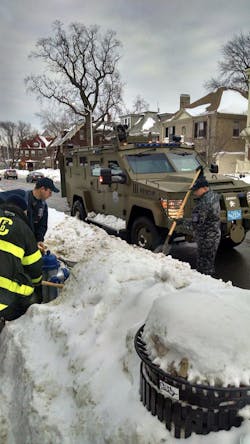In January, 2015, the nation watched as the East Coast endured record winter conditions. Dubbed the “Blizzard of 2015”, communities faced zero visibility, unrelenting snow and winds. Travel bans were in place and a state of emergency declared. Nearly 4,800 flights were cancelled and over a thousand more delayed. People endured loss of power for days. In the end, the Boston (Mass.) area recorded a record 110.6 inches of snow for 2014 to 2015 with 64.8 inches falling in February alone. The average annual snowfall: 43.5 inches. Even though the East Coast faced horrific conditions with a national audience, law enforcement agencies were ready to handle this environmental emergency. And one of these agencies, Cambridge PD, sits just across the Charles River from Boston.
Day after day, after day
Unlike tornadoes or earthquakes, environmental emergencies such as snow, heat waves, and flooding due to excessive rainfall require law enforcement agencies to develop a plan for longer term public safety concerns. One of the most important things Cambridge Police Department did was establish a unified, centrally located command. “From a law enforcement standpoint you have to look at what potential there is for anything to go wrong,” says Jack Albert, Deputy Superintendent, Cambridge PD. With 29 years in law enforcement, Albert says he hasn’t missed many snow storms. “We already knew that the governor was going to declare an emergency,” he says. The next step was to get all the players in place before the worst hit. The team established a command post and brought in all the key players: law enforcement, fire, EMS, human services and other important agencies, and housed them in a central location. “They slept on cots at the station and we also got discounted hotel rooms within walking distance,” he said. “We sent All-Wheel Drive (AWD) vehicles to go get them.”
Cambridge’s command post was established prior to the blizzard with top-of-the-line equipment and a robust system. “We asked our techs to have it up and running four hours before the blizzard began,” Albert says. The city manager required every agency send one person for staffing. “If something came up, we had people there who could answer the question,” he says. “We didn’t have to go find someone.” Knowing how they were going to establish the command post and having it ready to go was part of Cambridge’s pre-planning. Having protocols in place prior-to seems to be a common thread in agencies successfully handling environmental emergencies. An agency clear across the country facing an entirely different issue agrees.
You can fry an egg
Unlike mounds of snow and chilling temperatures, agencies across California have the opposite concern—heat. The Summer of 2015 has been brutal on the region following a dry winter and spring. The City of Sacramento, normally temperate due to a delta breeze, struggled when a strong high pressure system built across the region. The month of June saw 19 days above 90 degrees, 5 above 100 and 2 reaching 105. In the middle of this heat wave, the city hosted the U.S. Senior Open. Fortunately, California Office of Emergency Services (Cal OES) was prepared.
“We at Cal OES worked very closely with other federal and local law enforcement,” says Mark N. Pazin, Chief of Law Enforcement for Cal OES. “I was out there for a couple days and the heat was just oppressive. It was miserable.” Working with others was part of Cal OES’ robust pre-planning stage. “It was very well executed,” states Pazin. In fact, at the end of the tournament, a representative from the U.S. Golf Association wanted a template so they could implement it at other national golf tournaments. Wanting to assist others, Cal OES established the “Contingency Plan for Excessive Heat Emergencies.” This 64-page document, available on their website, gives agencies a step-by-step guide on how to prepare for heat.
“It’s interesting how people forget the basic rules in a heat emergency,” Pazin says. Reminiscing about his time as the Merced County (Calif.) Sheriff, Pazin recalls a three week period of time when the temperature reached triple digits. “People were not prepared for it, although we advertised and put it through the media.” With Cal OES’ plan, he hopes that people are aware they have a government agency they can reach out to during critical times. “We have become the governor’s Swiss Army knife,” says Pazin. “We are utility players.” This utilitarianism is why it is essential to pre-plan.
“When we talk about weather conditions over the last decade, we have seen more horrific weather conditions than we have seen in a long time,” says Mary Beth Ormiston, strategic programs manager in safety and risk management, FacilityDude, a company offering software solution, Crisis Plan. “The expectation of our public has changed,” she says. “We are expected to be better prepared.” This mobile platform allows agencies to establish and easily update community action plans (CAP). “Most of our CAPs are on paper,” says Ormiston. “As soon as you publish them they are out of date.” With Crisis Plan, everything is immediately updated, including evacuation routes, contact information and compliance checklists. The software is customizable and brings together high-tech with common sense flexibility. Ormiston says “Our public demands we know how to react. Because we have the technology, and technology and data are power. We understand we have more options available to keep people safer than ever before.” Another region that understands the importance of pre-planning and utilizing technology is Liberty County, Texas.
Water, water all around
The Trinity River travels 423 miles from the northern border of Texas to the Gulf of Mexico. Its basin covers nearly 18,000 square miles. In Liberty County the water flows into 90,000 acre Lake Livingston and is then controlled by the gates of the Lake Livingston Dam. Normally, the dam allows around 1,000 to 2,000 cubic feet a second (cfs) through the spillway gates. But when the water begins to rise due to rain, the amount of water increases exponentially and threatens communities downstream. Since May, the basin has recorded over 20 inches of rain and by May 27, the dam was releasing 72,600 cfs of water. At the time of this writing, Liberty County was in day 57 of flooding with the dam still releasing 28,400 cfs a day. One of the agencies handling this environmental emergency is the Liberty County Office of Emergency Management.
With 10 incorporated cities, 12 law enforcement agencies, 15 fire departments and 7 school districts, Liberty County has a lot to manage even when the water is not threatening to wash everything away. Emergency Management Coordinator Tom Branch says the issues facing law enforcement are different than the type they face in areas prone to flash flooding. “We don’t have that kind of flood here,” says Branch referencing the conditions that areas such as Wimberely, Texas faced Memorial Day weekend. “We have a slow rising flood,” he says. “We have the occasion to plan for this. We watched the radar and the National Weather Service. We talked to the senior hydrologist. We monitor things and we visit with people who are in the know. We take all that data and we pass it on to our county officials.” Like Cambridge and California, pre-planning was essential. What all the agencies found dealing with their own environmental issues was successful public safety required two essential elements.
Relationship
Establishment of relationships prior to crisis events is vital. “The key to success is making sure that we work with all the public safety partners,” says Pazin. “We try not to silo issues. We are all in this together because we have overlapping public missions.” He also agreed knowing all of the public safety partners prior to an emergency or event is key to success. “We try to avoid e-mails and text which is so impersonal,” he says. “When something does go awry you want to know who you are working with.” Albert agrees stating all the players in the Boston area are involved in planning. “You have that familiarity. You’re not waiting for the event to occur to start networking and making contacts. There were no surprises.”
Communication
The second element is communication, both internal and external. “My job is to make sure that all the law enforcement is informed,” says Branch. “We send out news releases twice a day when there is an incident letting them know what to expect. Then the law enforcement folks go out and feed information back to me.” Communication comes from and leads to trust between agencies. “Everybody has to know that when someone says something serious is happening, we have to take that and go with it,” says Branch. He also mentioned it is important everyone knows their role. “Our division chief talks about staying in our lane. My background is law enforcement but my role is emergency management now. So I don’t need to be in law enforcement’s lane telling them what to do.” Along with internal respect and communication, it is important to know how to communicate with non-public safety partners, as well as the community.
With two large universities, Harvard and Massachusetts Institute of Technology (MIT) within their jurisdiction, along with a large business community, Cambridge had to be effective with external communication during the blizzard. “We have a highly educated population who are tuned into social media,” says Albert. “It is a lot easier to reach out to them.” The city established #CambMASnow for all communications reference the blizzard. “It was used by everyone,” says Jeremy Warnick, Cambridge PD, Director of Communications and Media Relations. “People went to that for everything. It provided a good source for consistent information.” One of the issues facing Cambridge was traffic congestion. With so much snow, many streets clogged leaving only one lane of traffic. Parking bans had to be ordered. With good communication, the 2015 ban left fewer cars to be dealt with. “When we made the announcement, we were so successful,” says Albert. “We towed so few cars it was amazing.” During a snow storm several years ago, prior to the focus on external communication, the city towed around 400 to 500 cars. In 2015, it was less than 200. Pazin and Branch both state they rely heavily on the media to provide information to the public. “Everybody has a website so if I send out a press release even our local newspaper will post it immediately,” says Branch. “In today’s electronic world, it’s easier to get the word out.”
Challenges
The biggest challenge when it comes to dealing with environmental emergencies? “The health and safety of the officers out in those conditions,” says Albert. “We have to have what we need to provide a service safely. You have to have the people and the equipment.” Ormiston reiterates having appropriate technology supports this goal and more. “By providing software programs to enable agencies to be better connected, it provides them an opportunity to do better long range planning, protects assets and helps improve awareness, readiness and response time during crisis,” she says. “It helps us reduce the liability exposure. It empowers police departments to have more information available to make decisions they need to make.” At the end of the day, she says having this kind of system saves lives, saves money, and helps agencies do the right thing.
Albert says none of it is easy. “It takes a lot of planning and is labor intensive. You have to be prepared to face any eventuality. You do that by pre-planning. It’s not just a snow event or a heat event. It could be a community event like July 4. What we practice in Cambridge and what we preach in Cambridge is everyone has to be willing to be at the table and be willing to contribute.” Branch explains their job is to protect the people. “We’re fortunate here because we have good people and organizations. They let me do my job. I let them do their job. And we get it done. We’re just taking care of business.” And getting it done was exactly what each of these agencies did when faced with Mother Nature.



![Panic Screen And Phone 11575084[1] Panic Screen And Phone 11575084[1]](https://img.officer.com/files/base/cygnus/ofcr/image/2020/06/panic_screen_and_phone_11575084_1_.5ef4af04e1f40.png?auto=format,compress&fit=crop&q=45&h=139&height=139&w=250&width=250)